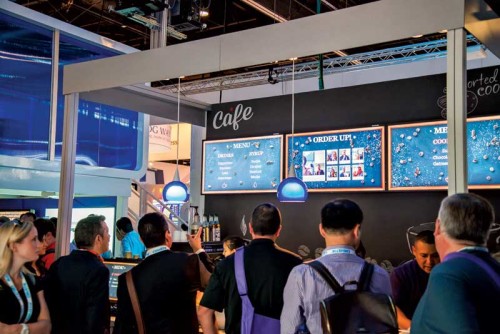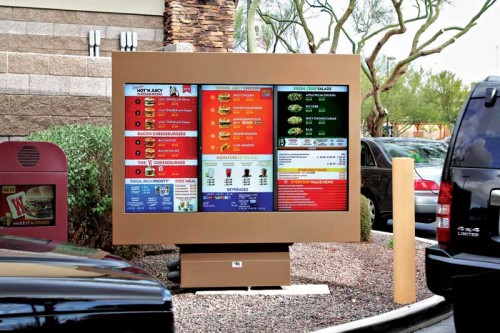Digital Signage: The expanding benefits of digital menu boards
by all | 14 April 2016 11:44 am

Photos courtesy NEC Display Solutions
By Ben Hardy
In May 2015, the Legislative Assembly of Ontario voted to pass the province’s Bill 45, the Making Healthier Choices Act. Scheduled to come into effect on January 1, 2017, the act will require all restaurant chains and other food-service providers with 20 or more locations operating under the same (or substantially the same) name within the province to display the calorie counts for each variety, flavour and size of their menus’ food and drink items, as well as standardized portions.
If any quick-service restaurant (QSR) chain or food-service provider does not comply with the act, it can incur penalties of up to $10,000 per day. And despite these steep fines, many restaurateurs may view the act as an unnecessary burden, cutting into their valuable time and profits. What they may not recognize, however, is the opportunity to conveniently and cost-effectively comply with the new regulations by switching from static to digital menu boards.
Further, by deploying digital signage, they will also be all the readier to implement any future menu updates or promotions.
Building better customer relationships
Digital menu boards have proven highly effective in recent years at capturing customers’ attention and increasing sales.
There is still a ‘wow’ factor with eye-catching, engaging content, including full-motion video, animation and bright colours. Even if customers have by now seen a lot of digital signage around them, the medium continues to reduce their perceived wait times in lineups, leading to a happier clientele.
The medium offers the flexibility to show different meals at different times of the day on the same board and allow managers to make other modifications at any time. These may include newly introduced and/or higher-profit-margin products during high-traffic periods, for example, or already-popular items to draw in more customers during typically slow times.
Self-serve kiosks are also beneficial to some QSRs, as they make it even easier to tailor and present additional food and beverage suggestions directly to customers through a point-of-purchase (POP) display. A customer ordering a sandwich, for example, can be prompted to add a salad that complements it.
Not only are helpful recommendations welcomed by many customers, but they can also upsell them on more expensive items. This capability has been exemplified by new McDonald’s ‘build-your-burger’ kiosks, which let people customize burgers with additional patties and toppings, for a correspondingly higher price.
Aside from the sales opportunities themselves, restaurant managers have started to see digital signage as a way to build a closer relationship with customers. The dynamic nature of the medium means a vast array of creative possibilities. Mouth-watering images of food and beverages may trigger initial interest, while subsequent images of comforting features like a fireplace can motivate people to stay longer and feel more at home. In this context, customers may also appreciate digital signage presenting nutritional information about menu items, as a helpful service.

Drive-thru digital menu boards need to be rugged, weatherproof and damage-resistant.
Adding business value
Today’s commercial-grade digital displays allow restaurants to present accurate brand images and colours with strong visual clarity, even in less-than-optimal viewing conditions.
Outdoors, for example, drive-thru digital menu boards need to be rugged, weatherproof and damage-resistant. And given the reality of restaurant kitchens, even indoor displays need
to be able to withstand high levels of heat and humidity. For these reasons, digital menu boards should be equipped with real-time temperature monitoring and heat dissipation capabilities, so their displayed images are not compromised by the nature of their location.
While rugged technology may seem prohibitively expensive upfront, it can be surprisingly affordable in the long run because of the added value it entails. When restaurant managers can control menu boards remotely and update content on the fly, there is no more waiting for new static materials to be printed, shipped and installed. Changes can even be made quickly throughout an entire restaurant chain, thanks to networked communications.
So, when it is used properly and creatively, digital signage not only helps restaurants make an already-welcoming environment even more inviting for customers, but also offers an attractive return on investment (ROI).
Further, as the technology continues to become more advanced, customers will eventually come to not only enjoy it, but expect it—and they may be disappointed if they do not see it in the restaurants they visit. With this in mind, sign shops are well-positioned to serve the QSR industry with digital signage hardware and services that benefit their clients’ brands.
Ben Hardy is a product manager for NEC Display Solutions, which manufactures large-screen public-information displays. For more information, contact him via e-mail at bhardy@necdisplay.com[1].
- bhardy@necdisplay.com: mailto:bhardy@necdisplay.com
Source URL: https://www.signmedia.ca/digital-signage-the-expanding-benefits-of-digital-menu-boards/